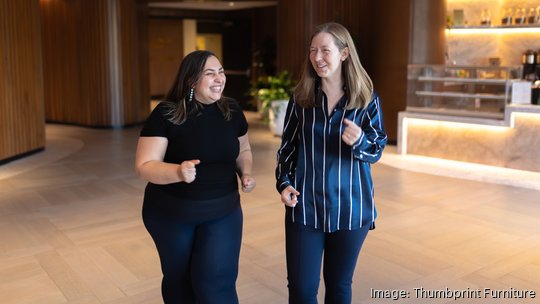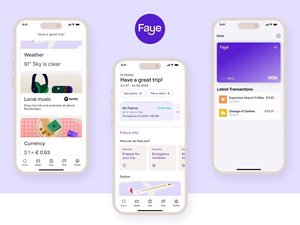
A Falls Church startup with an artificial intelligence-powered platform capable of producing interior design plans for office spaces in minutes has raised $1.75 million to fuel its growth.
Thumbprint Furniture, co-founded in May 2023 by CEO Katherine D’Zmura Friedman and Chief Technology Officer Sasha Perebikovsky, plans to use the funds to help nab more partnerships with furniture manufacturers and dealers while expanding its workforce to keep up with customer demand.
The Virginia Innovation Partnership Corporation was among its backers in the funding round led by venture capital firm Brilliant Partners Fund and with participation from Iron Prairie Ventures, Apprentis Ventures and Yonder Ventures.
In an interview, Friedman told me she began developing the platform during her decade of working in the furniture and interior design sectors, mostly in sales-related roles. She recounted how many designers expressed frustration, herself included, with the time it took to find and source all the various furniture pieces that make up a space, a task that often required sifting through furniture manufacturer catalogs containing tens of thousands of items.
But with Thumbprint's automated platform, much of that laborious work can be accomplished in minutes as the software tool helps users source these items from an inventory of desks, chairs and tables supplied by furniture manufacturers and design spaces.
"I would have killed to have Thumbprint when I was working in the industry," Friedman said. "Speed-to-market is definitely one of the biggest challenges right now and we're solving that problem head-on. The reason why I decided to shift from being in the industry to helping the industry as a whole was because there's just nothing else out there tackling the problem. If there was, I'd still be selling furniture."
Friedman built the initial prototype of Thrumbprint during weeknights and on weekends using no-to-low-code tools. She then enlisted Perebikovsky, her best friend who has a background in tech and a doctorate in physics, to help turn the prototype into a working platform, which formally launched in June.
Thumbprint's clients include furniture manufacturers, dealers and interior designers, all of which pay a subscription to Thumbprint to either have products featured on the platform or to access the platform itself.
Thumbprint, which has grown to 23 full-time employees over the past year, says more than 100 firms or individuals are using the platform, a figure that's expected to grow as more and more manufacturers get furniture catalogs onboarded into the platform. That process can take between three and six months depending on the number of items a given manufacturer wants to list.
A floor plan with measurement dimensions is all the platform needs to design a given space, though those who interact with it can also configure certain filters like style and color preferences, for instance. Thumbprint will then generate a list of all the furniture a designed space requires and where that furniture can be sourced from among the manufacturers and dealers that are on Thumbprint's platform.
"We are building the ultimate furniture machine," Friedman said.
Growing its software engineer count is important for the months ahead, Friedman said as she also looks to expand the startup's sales and marketing teams, too. In total, she imagines hiring about 10 more people in the next year, and while she's the only one at the company that calls Greater Washington home, Friedman expects to be more intentional about hiring in the region going forward.
Friedman, an alumna of the Parsons School of Design at The New School in New York, downplayed the possibility that the company's AI platform could replace interior designers. Yes, Thumbprint's interior design sketches can generate in minutes what might take an entire design team several weeks to complete, but as she sees it, that frees up designers to spend more time with clients and on fine-tuning the designs themselves.
"This way the designer is really playing the role of the editor and the curator and setting the pace for the aesthetic intent, rather than essentially going through the tedium of one by one doing everything by hand," Friedman said.




